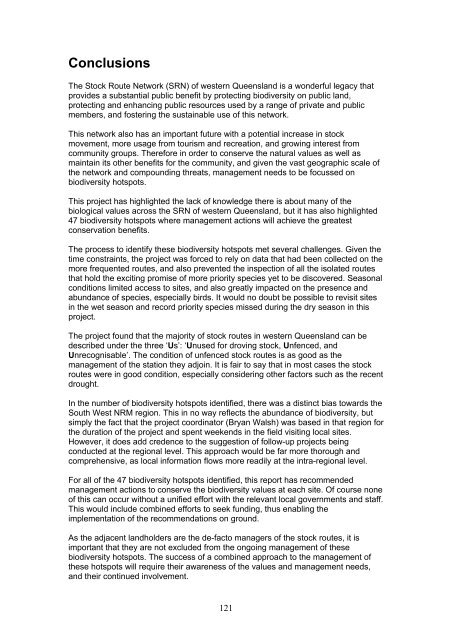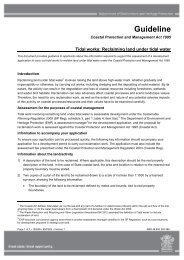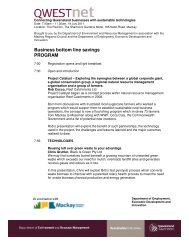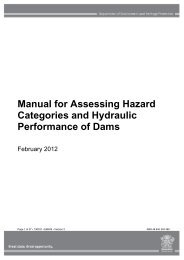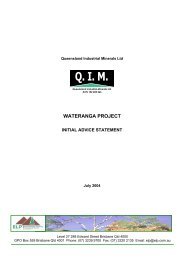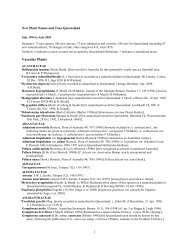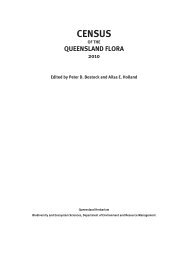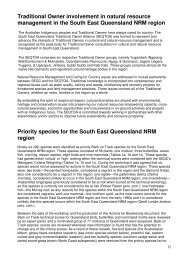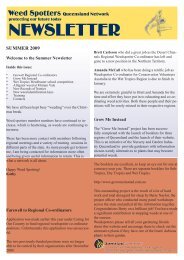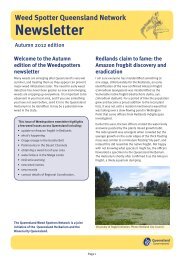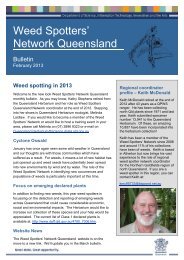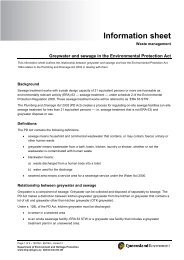Enhancing Biodiversity Hotspots Along Western Queensland Stock ...
Enhancing Biodiversity Hotspots Along Western Queensland Stock ...
Enhancing Biodiversity Hotspots Along Western Queensland Stock ...
Create successful ePaper yourself
Turn your PDF publications into a flip-book with our unique Google optimized e-Paper software.
Conclusions<br />
The <strong>Stock</strong> Route Network (SRN) of western <strong>Queensland</strong> is a wonderful legacy that<br />
provides a substantial public benefit by protecting biodiversity on public land,<br />
protecting and enhancing public resources used by a range of private and public<br />
members, and fostering the sustainable use of this network.<br />
This network also has an important future with a potential increase in stock<br />
movement, more usage from tourism and recreation, and growing interest from<br />
community groups. Therefore in order to conserve the natural values as well as<br />
maintain its other benefits for the community, and given the vast geographic scale of<br />
the network and compounding threats, management needs to be focussed on<br />
biodiversity hotspots.<br />
This project has highlighted the lack of knowledge there is about many of the<br />
biological values across the SRN of western <strong>Queensland</strong>, but it has also highlighted<br />
47 biodiversity hotspots where management actions will achieve the greatest<br />
conservation benefits.<br />
The process to identify these biodiversity hotspots met several challenges. Given the<br />
time constraints, the project was forced to rely on data that had been collected on the<br />
more frequented routes, and also prevented the inspection of all the isolated routes<br />
that hold the exciting promise of more priority species yet to be discovered. Seasonal<br />
conditions limited access to sites, and also greatly impacted on the presence and<br />
abundance of species, especially birds. It would no doubt be possible to revisit sites<br />
in the wet season and record priority species missed during the dry season in this<br />
project.<br />
The project found that the majority of stock routes in western <strong>Queensland</strong> can be<br />
described under the three ‘Us’: ‘Unused for droving stock, Unfenced, and<br />
Unrecognisable’. The condition of unfenced stock routes is as good as the<br />
management of the station they adjoin. It is fair to say that in most cases the stock<br />
routes were in good condition, especially considering other factors such as the recent<br />
drought.<br />
In the number of biodiversity hotspots identified, there was a distinct bias towards the<br />
South West NRM region. This in no way reflects the abundance of biodiversity, but<br />
simply the fact that the project coordinator (Bryan Walsh) was based in that region for<br />
the duration of the project and spent weekends in the field visiting local sites.<br />
However, it does add credence to the suggestion of follow-up projects being<br />
conducted at the regional level. This approach would be far more thorough and<br />
comprehensive, as local information flows more readily at the intra-regional level.<br />
For all of the 47 biodiversity hotspots identified, this report has recommended<br />
management actions to conserve the biodiversity values at each site. Of course none<br />
of this can occur without a unified effort with the relevant local governments and staff.<br />
This would include combined efforts to seek funding, thus enabling the<br />
implementation of the recommendations on ground.<br />
As the adjacent landholders are the de-facto managers of the stock routes, it is<br />
important that they are not excluded from the ongoing management of these<br />
biodiversity hotspots. The success of a combined approach to the management of<br />
these hotspots will require their awareness of the values and management needs,<br />
and their continued involvement.<br />
121


